Songs Illustrated by Tuck Part II
The postcard world was rocked to its very foundation when the bombs fell on London in the winter of 1940. Those bombs destroyed the warehouses of art, paper stock, machinery, ink and the corporate records of the Raphael Tuck and Sons, By Appointment, “Art Publishers to Their Majesties the King & Queen.”
Thanks, has gone to the heavens from generations since then because Tuck was a very successful company and their products reached every corner of the earth. The postcards made by Tuck number in the many millions, and today the hobby we all enjoy is very different because of what happened that December night.
Two characteristics of the Tuck company were diversity and perfection. From both the arts and the sciences, Tuck made postcards to satisfy every curiosity and every taste. Tuck hired the best artists, photographers and print professionals to make those postcards. And, much of their professional time was devoted to making postcards that illustrated the ballads, ditties, poems, hymns and songs that were so much a part of British, Irish, and American society.
This checklist is designed to help collectors of Tuck’s Illustrated Songs series. It includes the basic information that identifies the fifteen sets – 90 cards in total – that qualify under the definition that the illustration must include at least a line from a ballad, poem, or song. The list also includes a representative sample from each set. The example is enhanced by a very brief history that we hope will be a challenge for collectors to do additional research that would – how is it said? – “… fill-in the blanks.”
PostcardHistory.net is proud to present this checklist to our readers; enjoy!
Tuck’s Illustrated Songs
#6241
Illustrated Songs Series VIII (6 cards) 1908
Artist: Duncan Hamish
- And Dear to this Bosom Is Charming Young Jessie*
- Ho-Ro, My Nut-Brown Maiden
- Sing to Me the Auld Scotch Songs
- She Whispered Modestly and Said…
- ‘Twas Thy Voice My Gentle Mary
- Will Ye Gang to the Hielands Lezzie Lindsay
*And Dear to this Bosom is Charming Young Jessie. Jessie is none other than “Jessie, the Flower of Dunblane.” This Scottish ballad was sung to every lass as a plea for love by the lads who wanted to win the heart of the sweetest girl in the village. Written by Tanny Hill, it first appeared in print circa 1815 in John Gilchrist’s Tales and Songs.
#6402
Popular Songs Illustrated (6 cards) 1904
Artist: Lance Thackeray
- I Ain’t A -Going to Tell.
- The Girl I Left Behind Me*
- The Lost Chord.
- The Promise of Life.
- There’s a Land
- Though the Rain Is on the River
*The Girl I Left Behind Me. This song is still in circulation [in 2000] and has enjoyed at least a dozen recordings. The lyrics recall how a young Irishman goes out to seek his fortune and finds ladies in foreign lands likeable but his heart “returns always to Erin’s Land” and the girl he left behind. The composer’s name has been lost to time.
#6455
Illustrated Songs (6 cards) 1908
Artist: Duncan Hamish
- Come into the Garden Maud*
- Come Where My Love Lies Dreaming
- I’m Leaving Thee in Sorrow, Annie
- Little Sweetheart, Come and Kiss Me
- My Mother Bids Me Bind My Hair
- Then You’ll Remember Me
* Come into the Garden, Maud. The Irish tenor John McCormick introduced this song to his audiences around 1905. Written by Michael Balfe in 1857, it was first a poem entitled, “Song for Maud” by Alfred ‘Lord’ Tennyson. Balfe not only wrote the music but added a few words of his own.
#6456
Illustrated Songs Series VII. (6 cards) 1911
Artist: Duncan Hamish
- A Boy’s Best Friend Is His Mother*
- So Early in the Morning
- Thy Face Is Ever Near
- Wait till the Clouds Roll By
- Where Are You Going To, My Pretty Maid?
- Who’s Dat a Callin’ So Sweet
*A Boy’s Best Friend is His Mother. This immensely popular song was written by a little-known composer name J. P. Skelly around 1883. The lyrics are “soapy” but in the end every boy learns that it’s his mother, “whose love is dearer far than any other. And wherever we may turn, this lesson we will learn-, that a boy’s best friend is his mother.”
#9052
Illustrated Songs (6 cards) 1911
Artist: Lance Thackeray
- As We Go Down the Vale, Lass!
- In Thy Bosom of Shade, With the Friends I Love Best*
- Just Down the Lane, Over the Stile
- Spring, Spring Beautiful Spring
- Stately Foxgloves, Tall and Fair
- The Miller’s Daughter
*In the Bosom of Shade, With Friends I Love Best. This phrase is the second line of the fourth verse of an Irish ballad called, “The Meeting of the Waters,” which conjures the warmth of friendships and links them to the Irish landscape. The lyrics come from the Irish poet, Sir Thomas Moore.
#9258
Illustrated Songs of Ireland (6 cards) 1911
Artist: Not Credited
- As Beauteous as Flora Is Charming Young Norah
- As I Went Out One Evening*
- Did You Not Hear of Kate Kearney
- Farewell, For I Must Leave Thee…
- I’ve A Cow for My Milk…
- O, The Days of the Kerry Dancing
*As I Went Out One Evening. This song is truly a piece of literary history. It may have been the first English language poem for two-voices. (The lines are read alternating a male and female voice; only when the lines are read together is the true story told.) It has been more than 100 years since this little-known music hall act included this song that became a favorite marching anthem during the First World War. It has outlasted many others to become one of the most popular songs of the 20th century.
To learn more about the songs of the British Isles, Google the history of a song entitled, It’s A Long, Long Way to Tipperary, by Jack Judge, a minor music hall performer who had never been to Tipperary.
When you finish your research you’ll be able to sing while you enjoy your postcards!
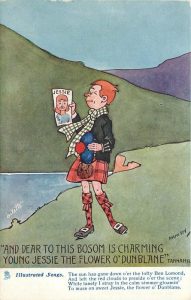

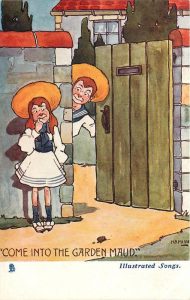
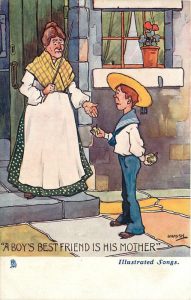
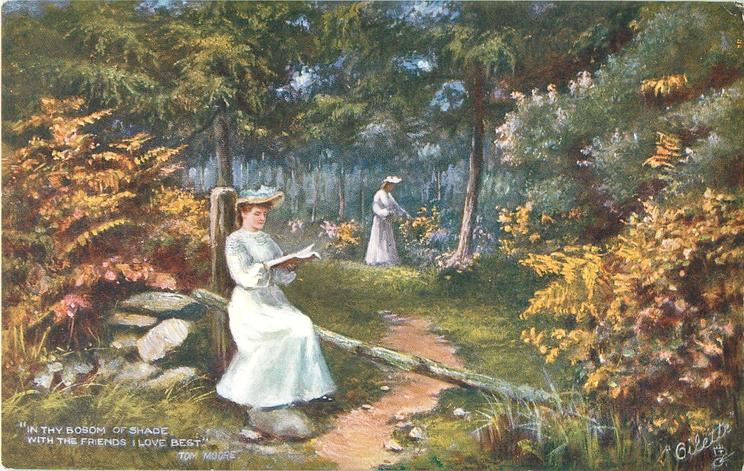
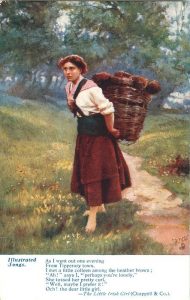
If you want to see more of the depth and breath of Tuck cards or perhaps you want to check on the number of cards to a set, see the incredible site Tuckdbpostcards.org
(db stands for database)
Nice & interesting cards.